GAIA LIVES
New island that emerged from the ocean off Japan is now visible from spaceHannah Osborne
Fri, November 10, 2023

The new island that emerged after an underwater volcanic eruption off Japan's Iwo Jima seen from space
A newborn island that recently emerged from the Pacific Ocean after an underwater volcanic eruption is now visible from space, images from the European Space Agency (ESA) reveal. The satellite images show the new landmass sitting around 0.6 mile (1 kilometer) off the coast off Japan's Iwo Jima island.
The submerged volcano began erupting on Oct. 21, with activity ramping up over the next 10 days. By Oct. 30, explosions were taking place every few minutes, according to a translated statement. The eruption threw large lumps of rock into the air, and shot a jet of gas and ash over 160 feet (50 meters) almost vertically above the water's surface.
Related: Scientists discover ancient, underwater volcano is still active — and covered in up to a million giant eggs
Since the volcano started erupting, "volcanic ash and rocks have piled up to form the new island, which is now also visible from space," a statement from the ESA said. The latest image was captured with the Landsat 9 satellite on Nov. 3. It shows Iwo Jima — which sits around 750 miles (1,200 km) south of Tokyo — before and after the latest eruption.
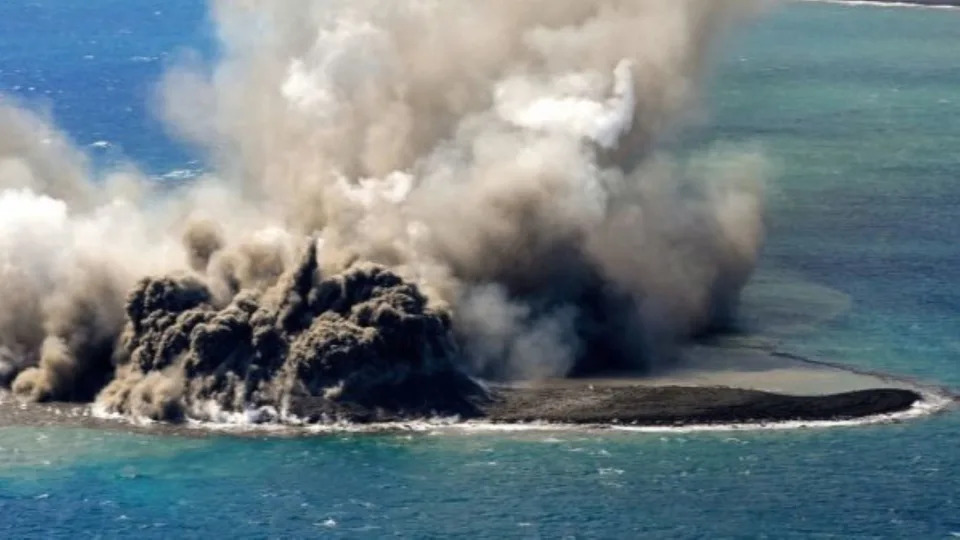
A close up of the new island that formed after a volcanic eruption.
Along with the new island, the volcano also produced a sea of floating pumice — an extremely porous type of rock that forms during explosive eruptions. New analysis of this pumice found its chemical composition differed from that of ejecta from other volcanoes in this chain, according to a different translated statement. The pumice likely came from an eruption along the back-arc rift zone — the area behind a volcanic arc, the statement noted.
RELATED STORIES
—Earth's newest 'baby' volcano is painting Iceland's Fagradalsfjall region with incandescent lava
—Perilous expedition to uninhabited island in South Atlantic confirms existence of world's 8th lava lake
—California's supervolcano has a massive lid that causes swarms of earthquakes — and that's a good thing, scientists say
The latest eruption is in almost the exact same spot as one that took place in July 2022, suggesting magma activity is resuming at Iwo Jima. The eruption has now subsided, Yuji Usui, an analyst with the Japan Meteorological Agency, told the AP.
The new island was approximately 330 feet (100 m) wide and up to 66 feet (20 m) high, but it appears to be shrinking as the waves erode the "crumbly" rock, Usui said. Whether the new island will survive is unclear and depends on what it is made of: If it is lava, it could remain for longer. "We just have to see the development," he told the AP.
A volcanic eruption gave birth to a new island, and a NASA satellite saw it from space (photo)
Robert Lea
Fri, November 10, 2023

A split-screen image of an island formed from a volcano eruption.
A NASA satellite has spotted a newly formed island off the coast of Japan that experienced a fiery birth at the end of October.
The joint NASA/U.S. Geological Survey satellite Landsat-9 saw the island rise from the sea off the coast of Iwo Jima island, part of the Volcano Islands archipelago in south Japan, on Nov. 3.
The island was born 750 miles (1,200 kilometers) south of Tokyo between 12:20 and 12:35 local time on Oct. 30 when blisteringly hot magma fell into the ocean and exploded, creating chunks of rock several feet long more than 160 feet (50 meters) into the air, according to the University of Tokyo.
"According to the Japan Meteorological Agency, the eruption appears to have started on October 21, 2023," University of Tokyo researchers wrote. "The location of this eruption is almost the same as the 2022 eruption location and is thought to indicate the resumption of magma activity on Iwo Jima."
The underwater eruptions broke the ocean's surface at two locations in the form of explosions at the southern tip of Iwo Jima, and rocks gathered to the north of these explosions. This growing rubble pile eventually formed a 330-foot (100-meter) wide island, around half a mile (1 kilometer) from Iwo Jima, sat in discolored water littered with very porous rock called pumice.
An extremely light rock, pumice is created when lava with a very high content of water and gases is discharged from a volcano. As gas bubbles escape this lava, it becomes "frothy," cooling and hardening into a bubble-filled rock.
Landsat-9 saw the island from its position 438 miles (705 kilometers) above Earth on Nov. 3, and this image was compared to observations of the region collected by the same satellite on Oct. 18 in which the island was not present.
The birth of the island was witnessed by a craft much closer to home when an aircraft owned by Mainichi Shimbun, a Japanese newspaper, was the initial stages of an underwater eruption in the southern part of the Izu-Ogasawara arc — an oceanic trench in the western Pacific Ocean.
The site of the new island has been a hotbed of underwater eruptions of steam and lava over recent years, University of Toyko researchers said, adding that this is one of the fastest-rising caldera volcanoes — a large depression formed when a volcano erupts and collapses — in the world.
Watch: New island appears off Japan coast – but it might not last long
Danielle Demetriou
Fri, November 10, 2023
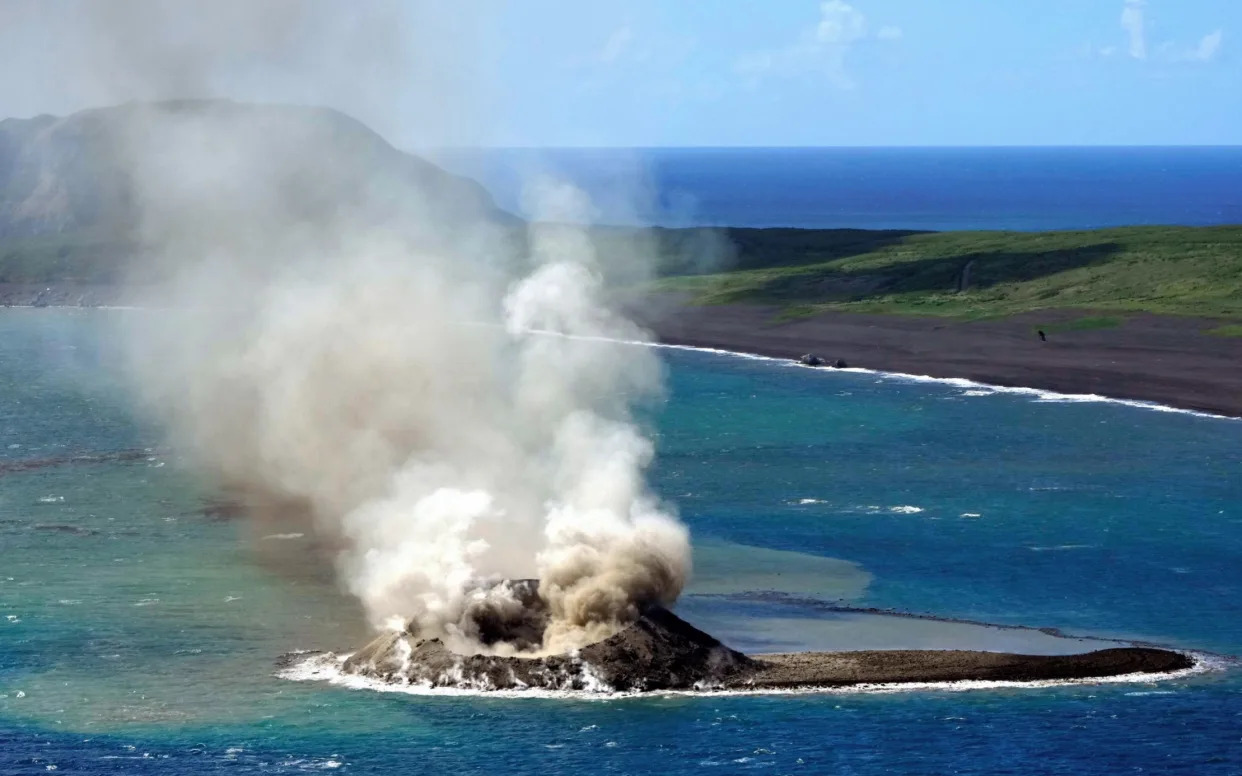
Earth and sand are sent into the air above a new islet off the coast of Iwoto island in Ogasawara, Tokyo, Japan - The Asahi Shimbun/Getty Images
A small new island has appeared unexpectedly off the coast of Japan following the eruption of an undersea volcano, although experts warn it may be washed away before long.
The land mass emerged from the Pacific Ocean after the volcano began a series of underwater eruptions late last month near the Ogasawara island chain.
It sits around 745 miles south of Tokyo and half a mile off Iwo Jima.
Eruptions led to volcanic ash and rocks accumulating on a shallow seabed and within 10 days, the tip of the unnamed island eventually emerged above the water.
The newly formed land mass then continued to grow, expanding to dimensions of around 330 feet in diameter, with a highest point of some 66 feet above sea level, by early November.
But volcanic activity at the site has since subsided and the island has now begun to shrink because its “crumbly” formation is easily washed away by waves, according to Yuji Usui, an analyst in the Japan Meteorological Agency’s volcanic division.
“We just have to see the development,” he said. “But the island may not last very long.”
The new landmass has risen from waters about half a mile off the coast of Iwoto – a volcanic island previously known as Iwo Jima, which was the scene of intense fighting during the Second World War.

In this aerial photo, plume billows out from the water off the Ioto island, following an eruption in Ogasawara, southern Tokyo, Japan - Kyodo News via AP
Fukashi Maeno, an associate professor at the University of Tokyo’s Earthquake Research Institute, discussed the creation of the island after flying over the site late last month.
Magma and seawater reportedly interacted to cause plumes of smoke to rise as high as 160 feet into the air every few minutes during eruptions, with large rocks also spewed from the waters, Mr Maeno told local media.
The intensity of the eruptions also caused the seawater to change colour, while pumice stones were spotted floating around the new island, he added.
The emergence of a new island is the latest in a long history of intense volcanic activity for Japan, one of the most seismically sensitive countries in the world, with more than 100 active volcanoes.
Undersea volcanoes and seismic activities have formed new islands in the past.
In 2013, an eruption at Nishinoshima in the Pacific Ocean south of Tokyo led to the formation of a new island, which kept growing during a decade long eruption of the volcano.
Located in the Pacific Ring of Fire, the Japanese archipelago spans the convergence of several major tectonic plates, resulting in centuries of frequent earthquakes and volcanic eruptions.
Experts are currently monitoring the region surrounding the new island to determine whether it will become a permanent fixture on Japan’s map or disappear.
The new island could survive longer if it is made of lava, or something more durable than volcanic rocks such as pumice.
An official at the Japan Meteorological Agency told local media: “If only a cinder eruption, as it is now, it will be eroded by waves and is unlikely to remain for a long time, but if it turns into an eruption with lava, it may remain for quite a while.”
New island forms in Japan after undersea volcano erupts but experts warn it may not last long
Joanna Adhem
Fri, November 10, 2023
In a remarkable event that unfolded three weeks ago, the eruption of an undersea volcano off the southern coast of Iwo Jima has created a new island.
Despite the awe-inspiring nature of this phenomenon, experts caution that the newfound landmass may not last long.
The unnamed undersea volcano, located roughly 1 kilometre off the coast of Iwo Jima - known as Ioto in Japan - and 1,200 kilometres south of Tokyo, erupted on October 21.
In just 10 days, volcanic ash and rocks built up on the shallow seabed, forming an island that emerged from below the water's surface.
By early November it was approximately 100 meters in diameter and had reached a height of 20 meters above sea level, according to Yuji Usui from the Japan Meteorological Agency's volcanic division.
This supervolcano in Italy last erupted in 1538. Is it about to blow again?
How long do experts think the island will last?
Two similar undersea eruptions have been documented in recent years, but the emergence of a distinct landmass is a rare occurrence.
The fragile nature of its composition, described as "crumbly" by Usui, makes it susceptible to erosion by ocean waves. Ongoing analysis by experts includes an examination of the deposits to determine exactly what it is made of.
It is still possible that the island could survive for a more extended period if it is composed of more durable materials such as lava, as opposed to the easily weathered volcanic rocks like pumice.
Japan has 111 of the roughly 1,500 active volcanoes in the world, according to the Japan Meteorological Agency. It sits on the so-called Pacific “Ring of Fire” - a 40,000-kilometre-long chain of volcanos and seismically active sites which is home to much of the world’s volcanic and earthquake activity.
Watch the video above to learn more about Japan's newest volcanic island.
Volcano creates a new island off Japan, but it may not last
The Associated Press
Fri, November 10, 2023

TOKYO (AP) — An undersea volcano erupted off Japan three weeks ago, providing a rare view of the birth of a tiny new island, but experts say it may not last very long.
The unnamed undersea volcano, located about 1 kilometer (half a mile) off the southern coast of Iwo Jima, which Japan calls Ioto, started its latest series of eruptions on Oct. 21.
Within 10 days, volcanic ash and rocks piled up on the shallow seabed, its tip rising above the sea surface. By early November, it became a new island about 100 meters (328 feet) in diameter and as high as 20 meters (66 feet) above the sea, according to Yuji Usui, an analyst in the Japan Meteorological Agency’s volcanic division.

This aerial photo shows steam billowing from the waters off Iwoto Island, Ogasawara town in the Pacific Ocean, southern Tokyo, on Oct. 30, 2023. A new island, 100 meters in diameter, formed by erupted rock, is seen near the steam, according to Kyodo News. (Kyodo News via AP)More

In this photo provided by the Japan Maritime Self-Defense Force, steam billows from the waters off Ioto island, Ogasawara town in the Pacific Ocean, southern Tokyo, on Nov. 1, 2023. An unnamed undersea volcano, located about 1 kilometer (half a mile) off the southern coast of Iwo Jima, which Japan calls Ioto, started its latest series of eruptions on Oct. 21. (Japan Maritime Self-Defense Force via AP)More

In this aerial photo, plume billows from the water off the Ioto island, following an eruption in Ogasawara, southern Tokyo, Japan, on Oct. 30, 2023. An unnamed undersea volcano, located about 1 kilometer (half a mile) off the southern coast of Iwo Jima, which Japan calls Ioto, started its latest series of eruptions on Oct. 21. (Kyodo News via AP)More

In this aerial photo, plume billows out from the water off the Ioto island, following an eruption in Ogasawara, southern Tokyo, Japan, on Oct. 30, 2023. An unnamed undersea volcano, located about 1 kilometer (half a mile) off the southern coast of Iwo Jima, which Japan calls Ioto, started its latest series of eruptions on Oct. 21. (Kyodo News via AP)More
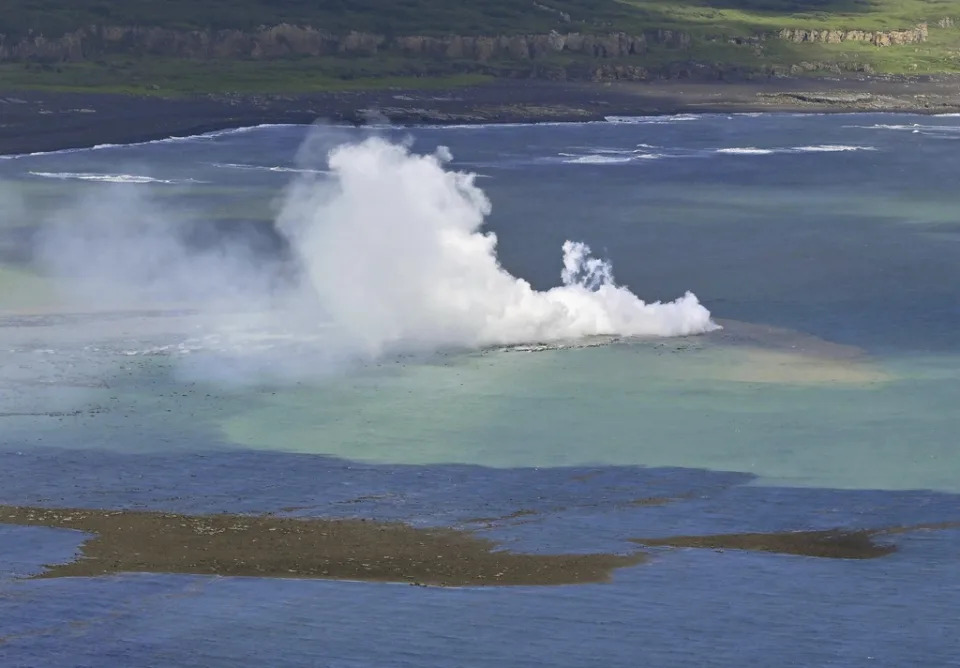
In this aerial photo, plume billows from the water off the Ioto island, seen rear, following an eruption in Ogasawara, southern Tokyo, Japan, on Oct. 30, 2023. An unnamed undersea volcano, located about 1 kilometer (half a mile) off the southern coast of Iwo Jima, which Japan calls Ioto, started its latest series of eruptions on Oct. 21. (Kyodo News via AP)More
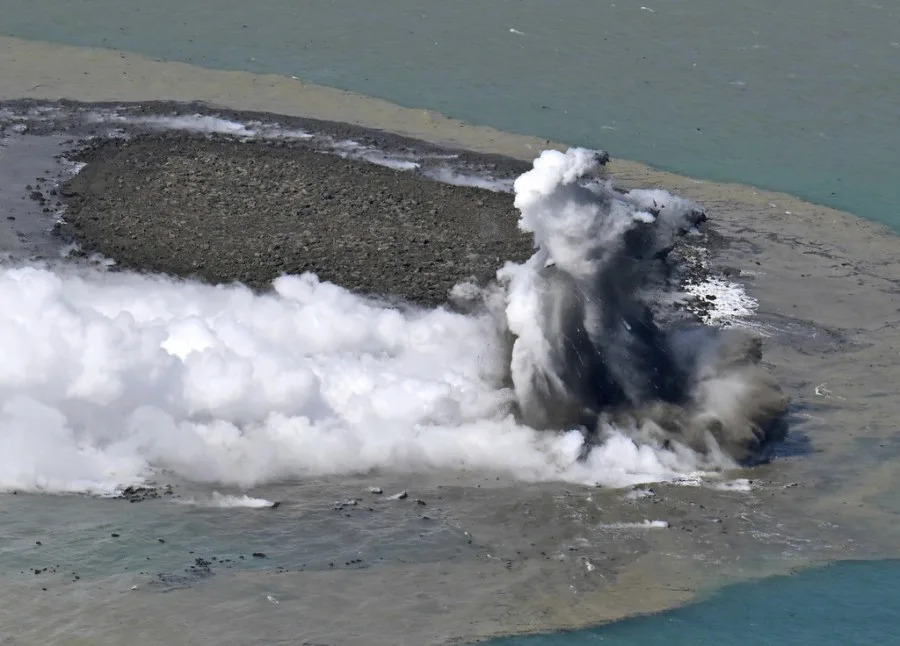
This aerial photo shows steam billowing from the waters off Iwoto Island, Ogasawara town in the Pacific Ocean, southern Tokyo, on Oct. 30, 2023. A new island, 100 meters in diameter, formed by erupted rock, is seen near the steam, according to Kyodo News. (Kyodo News via AP)More

This aerial photo shows steam billowing from the waters off Iwoto Island, Ogasawara town in the Pacific Ocean, southern Tokyo, on Oct. 30, 2023. A new island, 100 meters in diameter, formed by erupted rock, is seen near the steam, according to Kyodo News. (Kyodo News via AP)More
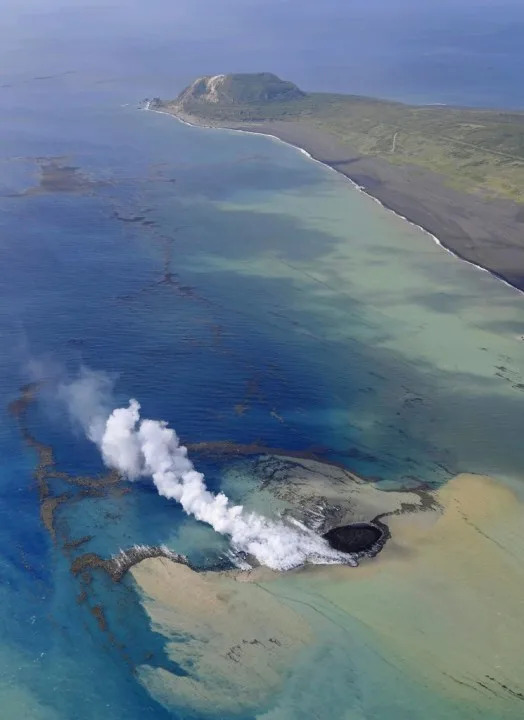
In this aerial photo, smoke billows from the water off the Ioto island, following an eruption in Ogasawara, southern Tokyo, Japan on Oct. 30, 2023. An unnamed undersea volcano, located about 1 kilometer (half a mile) off the southern coast of Iwo Jima, which Japan calls Ioto, started its latest series of eruptions on Oct. 21. (Kyodo News via AP)More
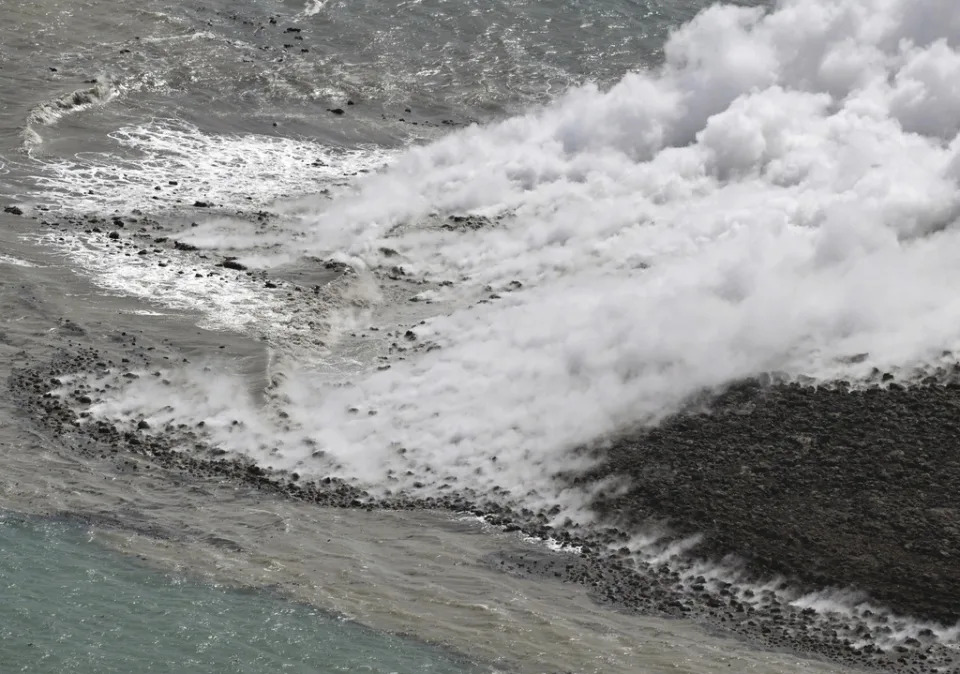
In this aerial photo, plume billows from the water off the Ioto island, following an eruption in Ogasawara, southern Tokyo, Japan, on Oct. 30, 2023. An unnamed undersea volcano, located about 1 kilometer (half a mile) off the southern coast of Iwo Jima, which Japan calls Ioto, started its latest series of eruptions on Oct. 21. (Kyodo News via AP)More
Volcanic activity has increased near Iwo Jima and similar undersea eruptions have occurred in recent years, but the formation of a new island is a significant development, Usui said.
Volcanic activity at the site has since subsided, and the newly formed island has somewhat shrunk because its “crumbly” formation is easily washed away by waves, Usui said.
He said experts are still analyzing the development, including details of the deposits. The new island could survive longer if it is made of lava or something more durable than volcanic rocks such as pumice.
“We just have to see the development,” he said. “But the island may not last very long.”
Undersea volcanoes and seismic activities have formed new islands in the past.
In 2013, an eruption at Nishinoshima in the Pacific Ocean south of Tokyo led to the formation of a new island, which kept growing during a decadelong eruption of the volcano.
Also in 2013, a small island surfaced from the seabed after a massive 7.7-magnitude earthquake in Pakistan. In 2015, a new island was formed as a result of a monthlong eruption of a submarine volcano off the coast of Tonga.
Of about 1,500 active volcanoes in the world, 111 are in Japan, which sits on the so-called Pacific “Ring of Fire,” according to the Japan Meteorological Agency.
Iwo Jima was the site of some of the fiercest fighting of World War II, and the photograph taken by AP photographer Joe Rosenthal of a flag-raising atop the island’s Mount Suribachi on Feb. 23, 1945, came to symbolize the Pacific War and the valor of the U.S. Marines.
World’s newest island forms off the coast of Japan thanks to undersea volcano
Rebecca Olds
Fri, November 10, 2023
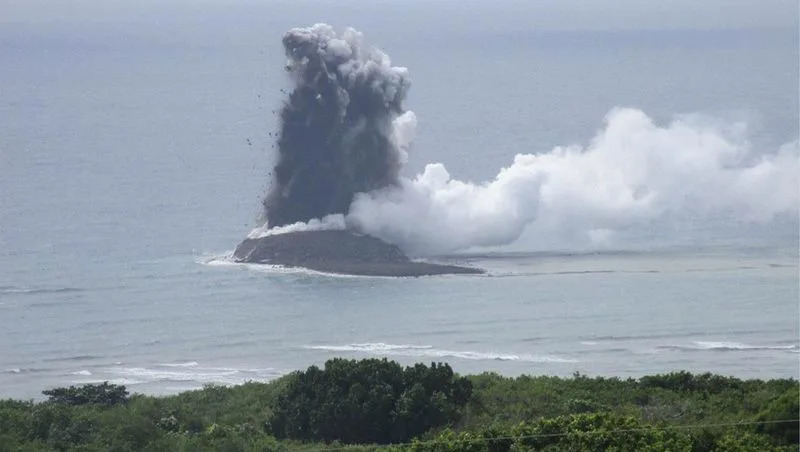
In this photo provided by the Japan Maritime Self-Defense Force, steam billows from the waters off Ioto island, Ogasawara town in the Pacific Ocean, southern Tokyo, on Nov. 1, 2023. An unnamed undersea volcano, located about half a mile off the southern coast of Iwo Jima, which Japan calls Ioto, started its latest series of eruptions on Oct. 21.
| Japan Maritime Self-Defense Force
A new island formed a week ago off the coast of the Japanese island Iwo Jima thanks to the work of an undersea volcano.
The unnamed volcano first began erupting on Oct. 21 and has spewed enough volcanic ash and rocks to start the formation of a new island, reported The Associated Press. The island is about 328 feet across and 66 feet above sea level.
One expert, Yuji Usui from the Japan Meteorological Agency’s volcanic division, told the AP that the island’s “crumbly” formation could be washed away by waves.
“We just have to see the development,” Usui said. “But the island may not last very long.”
For now, the volcano continues to eject a mixture of large gray particles and magma. No injuries have been reported from the event, reported The New York Times.
How can islands be created?
Islands can be created in a variety of ways, but the new island off the coast of Japan is attributed to the build-up of enough material from the underwater volcano that the pile has reached the surface, per The Associated Press.
Did Japan find 7,000 new islands?
The new island adds to the thousands discovered earlier this year in the region.
The Guardian reported that it was previously thought that the Japanese archipelago had around 6,000 smaller islands with four main ones. Then, digital mapping discovered that there were actually more than twice that many.
More than 7,000 new islands were discovered in early 2023.
Japan recounts its number of islands, discovering more than 7,000
A new island formed a week ago off the coast of the Japanese island Iwo Jima thanks to the work of an undersea volcano.
The unnamed volcano first began erupting on Oct. 21 and has spewed enough volcanic ash and rocks to start the formation of a new island, reported The Associated Press. The island is about 328 feet across and 66 feet above sea level.
One expert, Yuji Usui from the Japan Meteorological Agency’s volcanic division, told the AP that the island’s “crumbly” formation could be washed away by waves.
“We just have to see the development,” Usui said. “But the island may not last very long.”
For now, the volcano continues to eject a mixture of large gray particles and magma. No injuries have been reported from the event, reported The New York Times.
How can islands be created?
Islands can be created in a variety of ways, but the new island off the coast of Japan is attributed to the build-up of enough material from the underwater volcano that the pile has reached the surface, per The Associated Press.
Did Japan find 7,000 new islands?
The new island adds to the thousands discovered earlier this year in the region.
The Guardian reported that it was previously thought that the Japanese archipelago had around 6,000 smaller islands with four main ones. Then, digital mapping discovered that there were actually more than twice that many.
More than 7,000 new islands were discovered in early 2023.
Japan recounts its number of islands, discovering more than 7,000
How many islands make up Japan in 2023?
With the discovery earlier this year, Japanese geographers believe there are a total of 14,152 islands in the region.
And it’s possible that more, smaller islands will continue to pop up since the area is part of the “Ring of Fire” region, known for volcanoes, per The Associated Press. Currently, 111 out of the world’s 1,500 active volcanos are in Japan.
What type of volcano is found on the islands of Japan?
The main type of volcano found in Japan is the stratovolcano, or composite volcano, per the National Parks of Japan. These volcanoes are created by layer after layer of ash and rock, especially pumice. There are also cinder cones and lava dome volcanoes in the country.
Are there any active volcanoes in Japan?
Most of the volcanos in Japan are considered “active” because they’ve erupted in the past 10,000 years, including the most famous Mount Fuji volcano, which hasn’t erupted since 1707, per the National Parks of Japan.
Sakurajima is considered the most active in the country because it experiences small eruptions almost daily, per the travel website Japan Guide.
Related
What’s going on with Italy’s supervolcano?
No comments:
Post a Comment